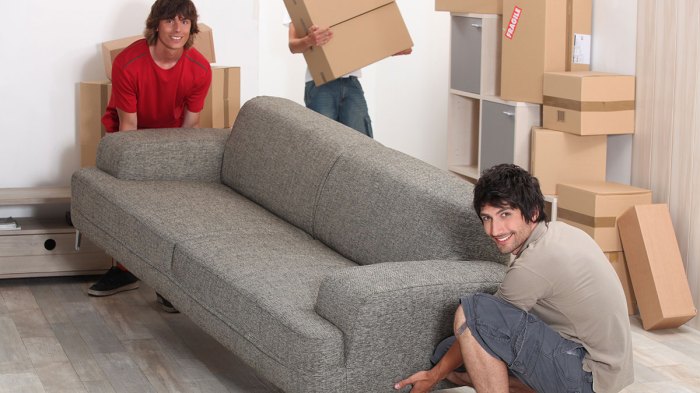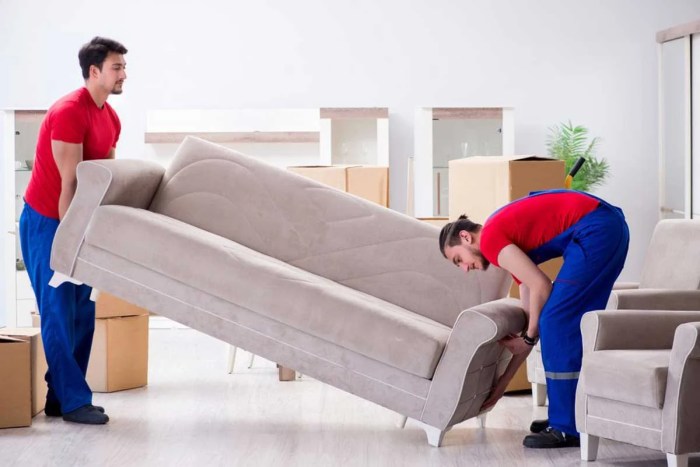As moving furniture help takes center stage, this opening passage beckons readers into a world crafted with knowledge, ensuring a reading experience that is both absorbing and distinctly original.
Whether you’re embarking on a cross-country move or simply rearranging your living room, furniture transportation can be a daunting task. This comprehensive guide provides a wealth of information, from professional moving services to DIY tips, tools, and techniques, empowering you to navigate the complexities of furniture relocation with ease and confidence.
Professional Moving Assistance

Hiring professional moving companies can alleviate the stress and physical demands of furniture moving. These companies possess expertise, equipment, and safety measures to ensure a seamless relocation.
Professional Moving Services
Reputable moving companies offer a range of services tailored to furniture moving needs:
- Packing and Unpacking:Professionals handle packing and unpacking your furniture with care, using appropriate materials and techniques.
- Furniture Disassembly and Assembly:They disassemble large furniture pieces for efficient transportation and reassemble them at the destination.
- Loading and Unloading:Trained movers utilize proper lifting techniques and specialized equipment to load and unload furniture safely.
- Transportation:Moving trucks are equipped with secure tie-downs and padding to prevent damage during transit.
- Insurance Coverage:Professional movers typically provide insurance to protect your furniture against potential damage or loss.
DIY Furniture Moving Tips
Moving furniture can be a daunting task, but it’s one that can be accomplished safely and efficiently with the right preparation and techniques. Whether you’re moving into a new home or simply rearranging your current space, following these DIY furniture moving tips will help you get the job done right.
Before you start moving furniture, it’s important to take some time to plan and prepare. This includes assessing the size and weight of your furniture, determining the best way to move it, and gathering the necessary supplies.
Packing
If you’re moving furniture that can be disassembled, such as tables or chairs, it’s a good idea to take it apart before moving it. This will make it easier to move and transport, and it will also help to protect the furniture from damage.
For furniture that cannot be disassembled, you’ll need to wrap it in protective materials such as blankets or moving pads. This will help to prevent scratches and dents.
When it comes to moving furniture, it’s not just about muscle power. You also need to ensure that your precious belongings are transported safely and securely. That’s where furniture shipping services come in. These professionals specialize in handling and transporting furniture, providing peace of mind during your move.
With their expertise and equipment, they can ensure that your furniture arrives at its destination in pristine condition, ready for you to enjoy in your new space.
Lifting Techniques
When lifting furniture, it’s important to use proper lifting techniques to avoid injury. This means bending your knees and lifting with your legs, not your back. You should also keep your back straight and your head up.
Moving furniture can be a hassle, but it doesn’t have to be. With the right help, you can get your furniture moved quickly and easily. If you’re looking for a reliable and affordable moving company, be sure to check out furniture shipped . They offer a wide range of moving services, including packing, loading, and unloading.
They can also help you with furniture assembly and disassembly. With their help, you can rest assured that your furniture will be moved safely and efficiently.
If you’re moving a heavy piece of furniture, it’s a good idea to get help from a friend or family member. This will help to prevent strain and injury.
Transporting Furniture
Once you’ve lifted the furniture, you’ll need to transport it to its new location. If you’re moving the furniture a short distance, you can simply carry it. However, if you’re moving the furniture a long distance, you’ll need to use a dolly or hand truck.
When using a dolly or hand truck, be sure to secure the furniture to the dolly or hand truck to prevent it from falling off.
Common Mistakes to Avoid
There are a few common mistakes that people make when moving furniture. These mistakes can lead to damage to the furniture or injury to yourself. Here are a few common mistakes to avoid:
- Lifting furniture with your back instead of your legs.
- Trying to move furniture that is too heavy for you.
- Not securing furniture to a dolly or hand truck.
- Moving furniture on a slippery surface.
- Not planning the move ahead of time.
Safety Precautions
Moving furniture can be a hazardous activity, so it’s important to take some safety precautions to avoid injury. Here are a few safety precautions to take:
- Wear closed-toe shoes and gloves.
- Clear the path of any obstacles.
- Be aware of your surroundings.
- Don’t lift furniture that is too heavy for you.
- Get help from a friend or family member if you’re moving a heavy piece of furniture.
Tools and Equipment for Furniture Moving

Moving furniture can be a daunting task, but the right tools and equipment can make it much easier. Here’s a table comparing some of the most common tools and equipment used for furniture moving, along with their functions, advantages, and safety features.
| Tool | Function | Advantages | Safety Features |
|---|---|---|---|
| Dolly | A platform with wheels used to move heavy objects | Can handle large and heavy items; reduces strain on the back | Look for dollies with locking wheels and non-slip surfaces |
| Straps | Long, heavy-duty straps used to secure furniture during transport | Prevents furniture from shifting or falling; can be used to tie down multiple items | Choose straps with high weight capacity and reinforced stitching |
| Furniture Sliders | Small, flat discs that are placed under furniture legs to make it easier to move | Reduces friction between furniture and the floor; allows furniture to be moved with less effort | Select sliders appropriate for the weight of the furniture and the type of flooring |
When choosing the right tools and equipment for furniture moving, consider the following:
- The size and weight of the furniture
- The distance the furniture needs to be moved
- The type of flooring
- The availability of assistance
By using the right tools and equipment, you can make furniture moving a safer and more efficient process.
Moving furniture can be a daunting task, but it doesn’t have to be. If you’re looking for professional help, consider hiring local furniture movers . They have the experience and expertise to move your furniture safely and efficiently. Plus, they can provide you with peace of mind knowing that your belongings are in good hands.
Moving furniture help is just a click away!
Furniture Disassembly and Assembly
Furniture disassembly and assembly are crucial steps in the moving process. Proper techniques and safety measures ensure the furniture’s integrity and your well-being. This guide provides a comprehensive overview of furniture disassembly and assembly, including step-by-step instructions, diagrams, and safety tips.
Step-by-Step Guide to Furniture Disassembly, Moving furniture help
Before disassembling furniture, gather the necessary tools, such as screwdrivers, wrenches, and a hammer. Read the assembly instructions carefully to identify the components and their connections. Follow these steps:
- Remove loose cushions, pillows, and other accessories.
- Disconnect wires, cables, or hoses attached to the furniture.
- Identify and remove screws, bolts, or other fasteners holding the furniture together.
- Gently separate the components, taking care not to damage them.
- Label the components and hardware for easy reassembly.
Step-by-Step Guide to Furniture Assembly
Once the furniture is disassembled, you can begin assembling it in the new location. Follow these steps:
- Identify the base or main frame of the furniture.
- Attach the components to the base using the screws, bolts, or fasteners removed during disassembly.
- Tighten the fasteners securely but avoid overtightening.
- Connect any wires, cables, or hoses to the furniture.
- Add the cushions, pillows, and accessories.
Techniques for Handling Different Types of Furniture
Different types of furniture require specific disassembly and assembly techniques. Here are some tips:
- Solid Wood Furniture:Use caution when disassembling and assembling solid wood furniture as it can be heavy and prone to damage.
- Upholstered Furniture:Remove the cushions and pillows before disassembling. Use a soft brush to clean the upholstery before reassembling.
- Glass Furniture:Handle glass furniture with care to avoid breakage. Wear gloves and wrap the glass in protective materials during disassembly and assembly.
- Metal Furniture:Metal furniture is often heavy, so use a dolly or furniture sliders to move it safely.
Common Assembly Challenges and Solutions
During assembly, you may encounter challenges. Here are some common issues and solutions:
- Missing or Lost Hardware:Contact the furniture manufacturer or purchase replacement hardware from a hardware store.
- Damaged Components:If a component is damaged, do not force it. Contact the furniture manufacturer for replacement parts.
- Difficulty Aligning Components:Use a level to ensure the components are aligned correctly. Tap them gently into place with a rubber mallet.
- Tightening Fasteners:Use a screwdriver or wrench to tighten the fasteners securely. Avoid overtightening.
Safety Tips
Always prioritize safety when disassembling and assembling furniture:
- Wear gloves and safety glasses to protect yourself from splinters and sharp edges.
- Use the appropriate tools for the job.
- Do not attempt to lift heavy furniture alone. Get assistance or use a dolly.
- Follow the manufacturer’s instructions carefully.
Space Planning and Furniture Placement: Moving Furniture Help

Effective furniture placement can transform a room’s functionality and aesthetics. It involves creating a cohesive layout that maximizes space, establishes focal points, and optimizes functionality.
Maximizing Space
- Use vertical space with tall bookshelves and cabinets.
- Choose furniture with built-in storage to reduce clutter.
- Hang mirrors to create the illusion of a larger space.
Creating Focal Points
A focal point draws attention and creates a sense of balance. Consider:
- A fireplace or large window
- A statement piece of furniture, such as a sofa or armchair
- A piece of artwork or a collection of items
Arranging Furniture for Functionality
Consider how you use the space and arrange furniture accordingly:
- Create conversation areas with seating facing each other.
- Ensure there is ample space to move around.
- Place furniture near electrical outlets and windows for access to light and power.
Impact of Furniture Placement on Room Design
Furniture placement influences the overall room design:
- It can create different moods and atmospheres.
- It can define the style of the room.
- It can affect the flow of traffic and the use of space.
Ultimate Conclusion
In the realm of furniture moving, knowledge is power. By embracing the insights and strategies Artikeld in this guide, you’ll transform the once-daunting task of furniture relocation into a manageable and even enjoyable experience. Whether you choose to enlist the expertise of professionals or tackle the challenge yourself, the information provided here will equip you with the tools and know-how to achieve a seamless and successful move.
Essential Questionnaire
How do I choose the right professional moving service?
Consider factors such as experience, reputation, equipment, and safety measures. Check online reviews, ask for recommendations, and compare quotes from multiple companies to find the best fit for your needs.
What are some common mistakes to avoid when moving furniture myself?
Overloading boxes, improper lifting techniques, and neglecting to protect furniture surfaces are common pitfalls. Plan carefully, lift with your legs, and use blankets or padding to prevent damage.
How can I maximize space when arranging furniture?
Consider the size and shape of the room, use vertical space, and create focal points. Experiment with different arrangements until you find one that optimizes functionality and aesthetics.